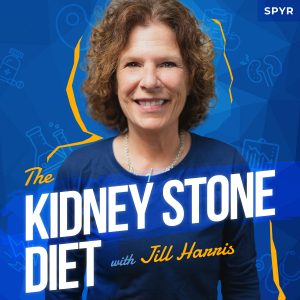This week, Jill answers a listener question about ways to reduce sodium in pre-made chicken and other ready to eat foods.
Jeff Sarris: Welcome back to the Kidney Stone Diet podcast, the show about reducing your kidney stone risk and living your best life. I’m your host and fellow student, Jeff Sarris.
Jill Harris: And I’m Jill Harris, your kidney stone prevention nurse.
Jeff Sarris: How’s it going? So you got the little Kidney Stone Diet logo on that one?
Jill Harris: Yeah, you know, people who listen to us on Spotify and Audible, or whatever, they must be like, “We don’t really give a damn. We don’t give a damn. We can’t see it. Why do you have to talk about it?” I don’t know. We just love them. We just love them. People like this one. Just a simple little kidney stone on them.
Jeff Sarris: Yeah, that’s definitely my vibe is always the simplicity. If it’s not clear because I’m always wearing one color and it’s black.
Jill Harris: Well, you look good in it. So I like that we have the opposites now, now that I don’t wear black every day.
Jeff Sarris: Yeah, you have all the colors going on there, especially with the whole line of stuff. There’s so many options.
Jill Harris: I look like a bag of Skittles on any given day! I mean, I really do now that you know, Easter’s here. I look like an Easter basket and if we dyed my hair grass green, because I have that kind of hair, Easter grass. I would look like an Easter basket these days. Why not? It’s happy. What was it gonna say? Oh, I have to ask the viewers. I’m on a mission, Jeff’s on a mission. We are on a mission to reach 10,000 subscribers and I know you’re all like, “Here that old lady goes again!” Well, I’ve done some research 64-65% of the people that watch our YouTube channel, we’re so grateful for you, but you didn’t click the red button.
Just click it, boop, click it, just click it. That’s all you have to do. And it doesn’t mean anything to you, but it means everything to us because people find us faster when they’re searching for kidney stone stuff in the YouTube channel search. So then people can get, you know, clinically correct information. Instead of, you know, if you smoke this cigarette and hit your head three times, you’re going to prevent or dissolve the stone, which we all know isn’t true. So, please press the subscribe button because I want to get 10,000 subscribers. Jeff said he wants to get 50,000, so y’all better be clicking that button right now. Thank you. And if you do click it, can you please tell us that you clicked it? So I can thank you in the comments because I don’t like asking for things and I don’t get to say “thank you” personally, so please do that. Okay, thank you.
Jeff Sarris: Yeah, that costs nothing. So that’s just helps with the algorithm and all the algorithm stuff is all a big mystery, always. But all these little markers always help, little likes on the videos, too. If you like it, it always helps. But yeah, so what do you say? Should we dive into this?
Jill Harris: Get on your swim cap, honey. Let’s go.
Jeff Sarris: Alrighty.
Can I rinse my food to remove sodium?
Listener Voicemail: Hi, Jill. My name is Jean. I’m from Crumpman, Indiana and I was diagnosed with kidney stones. I have a question for you. If something has a lot of sodium in it, say you buy chicken breasts that are already grilled and they’re in strips, what if you were to rinse your food to remove some of the sodium? Does it actually reduce the sodium count in your food when you rinse your food that has high sodium? Just curious. Appreciate the feedback! Thanks. Love you, bye.
Jill Harris: Jean, I love you, too, first of all, because we all need more love in the world. I feel so lucky a lot of people say that to me and I always say it right back because the world could use some extra love. I love it, myself. So, Jean, thank you for that. I appreciate you. I also appreciate everybody that calls in. You don’t have to do this. It’s part of your day, you’re taking up time, so the fact that you dialed those numbers and asked us this question is pretty remarkable. So, Jean in Indiana, yeah, sure. If you boil some food, the salt’s going to come out in the water. If you rinsed out a can of tuna–I do that when I’m having a can of tuna–if you bought storebought chicken, you know, you could probably get the salt on the top of it out.
If you boiled it for a while, yes, you are going to reduce the sodium in it. You will. I don’t know how much. It would depend on how long you were rinsing it. Would it be worth you doing at that point? Is it going to take away some of the flavor? Obviously, yes. Is it going to ruin the feel of that already made chicken breast? It may. Here’s some things. Instead of going through all that, you certainly can because it will reduce, you’re just not going to know exactly how much it’s going to reduce it by. Here’s other things I would say. Instead of putting yourself through that, something that’s already cooked, I would say–and Jean’s probably going to be like, “Well, I get it, girl, but I don’t want to have to cook the chicken. That’s why I’m getting a premade.”
Try this low sodium, pre-made chicken hack!
Could you find like at Trader Joe’s–Trader Joe’s is not by everybody, but I want you to know this. Trader Joe’s does sell with all their vegetables and stuff, on the right hand side, if you will, all the way down, you’re going to see pre cooked chicken. It typically is on the bottom shelf, under like some pre-made sandwiches and stuff. Here’s the veggies and then you get to the end of it and you’re gonna see all these premade things, and they have some grilled chicken with very low salt. So, on those weeks when I’m really busy, and I’m like, “I’ve got to get a couple pre-made chickens,” they have grilled chicken breasts. One is rosemary balsamic and another one is lemon and they are friggin’ delicious. They don’t salt these chickens, so you can get a big massive breast and they are very good.
So look for prepared chickens that have lower salt. Also-and you won’t like this, Jean-more times than not, I’m making my own chicken, meaning I get the breasts from the store. I put a little olive oil in a pan. I put it on medium-high heat. I get that chicken cooking on one side for about a minute. I turn it over. I put the heat down to simmer. I cover the pan for 15 minutes. I go do something else. Give me the 15-minute alarm and my chicken’s done for the week because I’ve just cooked four chicken breasts. That’s it. It’s so easy, less expensive. No salt. And then I’ll put some rosemary or I just use fresh herbs instead of sodium. I use fresh herbs.
And, Jean, I’m not saying all the time, but, honestly, you could do your own lemon pepper like Trader Joe does. It’s 15 minutes. That’s it. I take it out of the bag. I take it out of the hoozy. Put it in the pan. That’s it. Medium-high, one minute, turn it over, put the hoozy back in the thing, the lid on the pan, down to simmer 15 minutes, so why not? And then you get like four nights or, you know, two lunches, two dinners, whatever you want to do. Okay, make chicken salad, whatever you want to do. I’m just saying it’s so easy. So you could have a combination of things.
Could you reduce some of the sodium by boiling the hell out of that or by rinsing it off? Yes. How much? We don’t really know. The other thing, Jean, is you could say, “I’m having that chicken, Jill. Shut up.” Okay, have the chicken. And if it’s extra salty, can you watch your salt for the rest of the day? So, maybe, who cares about that much salt, right? Could you have less of a portion of that chicken and have more vegetables for that meal if you’re wondering about the salt? And then, also, so you don’t have to rinse it, and wash it, and all that other stuff?
So there’s, as I always say, many ways to skin a cat. So, you know, you could just have a little less of that chicken and then that’s going to be less salt and have more veggies. But, yes, to answer your question, you could reduce the salt. I’m just saying you won’t know how much, quite frankly, of that salt is going to wash away. So many different ways to do it, but, yes, you can.
Jeff Sarris: And it is tough because when we’re trying to track, then, it’s sort of a big question mark. Is it very reduced? Is it barely reduced? And sort of what are we talking about? So it’s a tough one to do.
Ask for low salt items at your grocery store!
Jill Harris: Yes, it is. But I will tell you what, though, for something that’s pre-made, I’m getting a little wishywashy about it because I’m not going to–then I shouldn’t have bought it if I’m worried about it. I’m just gonna make my own or I’m gonna have and have less and be done with it. But for canned foods, I always rinse stuff. I always rinse stuff. Something that’s pre-made, I don’t want to mess it up. It’s already pre-made. Does that make sense, Jeff?
Jeff Sarris: Yeah, it definitely does. It is tough because it’s the expediency of having it made, having it seasoned and salted. And, unfortunately, most pre-made food is very high sodium. Salt tastes good. It’s something that like immediately can make you feel positive about the product, so it gets overused. Unfortunately, restaurants, too, same thing. It just used with a heavy hand.
Jill Harris: People will say, “Jill, you need to open up a restaurant! Why aren’t there Kidney Stone Diet-safe restaurants?” Nobody’s coming, people. Nobody’s coming. Let me tell you. So yes, the kidney stone formers will come there will there will be people but the point is, food manufacturers make what we buy. And so when you’re first starting a low salt diet, as my kidney stone formers know, they’re like, “This is kind of bland.” Because you’re so used to the salt. You don’t taste your food anymore. You just taste salt, right? So, food manufacturers make what we buy.
If we buy lower salt products, they’ll make it look what keto did for sugar. Every product is low sugar now, low sugar, low sugar, no sugar added because keto, that diet, made everybody ask for: “We don’t want any sugar.” And so what food manufacturers do, okay? People want low sugar, we’re gonna make that, but focus groups say that when we give them the low sugar, it tastes junky, so we’re gonna have to put more salt in there, right? And sugar leaves a certain taste in our mouth. There’s all kinds of things. It’s about mouthfeel. Taste, but also mouthfeel and what it does. It conjures up these comforting thoughts, right?
So food is an amazing business. And so these food manufacturers have to answer to Wall Street, if we don’t buy the products, they don’t sell, they’re gonna have to answer to Wall Street, right? So, people will also say, well, these food manufacturers are making us sick while we’re buying the products. So I mean, stop buying the products. Look for lower salt, lower sugar versions of things. You could see a lot more low salt these days, too, in ketchup, in rotisserie chickens. I always buy a low salt rotisserie chicken at my grocery store. Ask your grocers to start making those rotisserie chickens without salt. They will if they’re bought.
People don’t think that they can go in the meat section and say, “Listen, can you make a cup of low salt rotisserie for me and my husband because we’re gonna buy him?” But you know what I’m saying? So, then they’ll make them and then if somebody sees the low salt little label on the rotisserie chicken on the big thing, they’re gonna be like, “Oh, wow,” and they’re gonna want one and then they’re going to ask. So ask for what you want people in food manufacturers. The more we ask the more they’ll make, but we have to buy it.
Look at gluten-free! Jeff’s like “Jesus Christ, Jill! We’re not talking about gluten-free. Jean asked about sodium and rinsing!” But look what gluten-free–most people buying gluten-free are not gluten sensitive. They just think it’s the healthy thing to do. Gluten-free on everything. From muffins, to bread, to cake, to everything. They bought it. They make it. They buy it and so it goes. So, start asking for lower salt items in your grocery store for ready made things and you’d be surprised what people do. But…what are we talking about?
Jeff Sarris: I mean, that’s the thing. If we’re supporting the things that we want to see, there will be more of them. It all takes time. The food sort of system is a big ship that–like gluten-free wasn’t overnight. That was over years and then the lower sugar, like we cranked up sugar for so many years. It took a long time for the sugar to come back down. So, that’s a whole balancing act.
Jill Harris: And it’s always something! In the ’80s, it was fat. And so what’d they do? They took fat out and put sugar in because, again, that mouthfeel we get when we’re eating something with fat in it, we like that. So, sugar can create that same mouthfeel, so the food manufacturers started putting more sugar in it because, again, focus groups were like, “This is disgusting without the fat. I don’t want this cookie.” So they put more sugar in it. The low-fat fad made us a hell of a lot fatter. I remember there was a Seinfeld episode where Elaine was eating the sugar-free froyo. It’s so funny! And she kept going in and kept going, “This is the best thing ever.” And it’s no sugar.
Jeff Sarris: Err, low fat! It was low fat at that time.
Jill Harris: Low fat, low fat. And then her friends, George and the guys, were like, “Huh,” and Elaine was like, “I’m not fitting in my pants anymore.” And then you know, but I’m just saying so we also want to believe that there is this miracle we’ll fill-in-the-blank, that we’re going to be able to eat as much as we want, and we’re gonna remain thin. It’s not how it is. It’s not how it is. So, all food, have your froyo. Have your snack wells, whatever the hell you’re doing, have it, and then get right back on track. That’s how we do it at Kidney Stone Diet. This kind of advice, people don’t want to hear it because they want to give up one thing, so they can eat as much as they want of something else.
That’s what the diet industry banks on. Take something away from patients or people, but tell them they can have as much as they want. This has no point, so have it. This is fine as long as you don’t have bread. I mean, you know, that’s what we want to do, but it doesn’t work long-term. For some people it does and God bless, but they’re not the norm. Most people are not able to do those kind of “take away this and you can have as much as you want of that” long-term. It just doesn’t work. We should be eating a wide variety of foods in normal portion sizes. Enjoy our things here and there and get right back on track. That’s how we do it.
Jeff Sarris: Yeah, so on that note, I think we should wrap for this week. In terms of staying on track, every weekend, Jill sends an email out to keep you inspired to stay on track and you can find that it’s a free email. You can subscribe it kidneystonediet.com. While there, you can find everything, the course, the meal plans, all the free content, all the 130-something episodes we have of this show, they’re all there. You can find everything you need at kidneystonediet.com. If you have a question and you want to be featured on the show, it’s 773-789-8763, and we’ll feature your voice on a future episode. I think that’s a good spot to wrap. With that, we will see you next week.
Jill Harris: Thanks, Jean, so much!














Leave a Reply